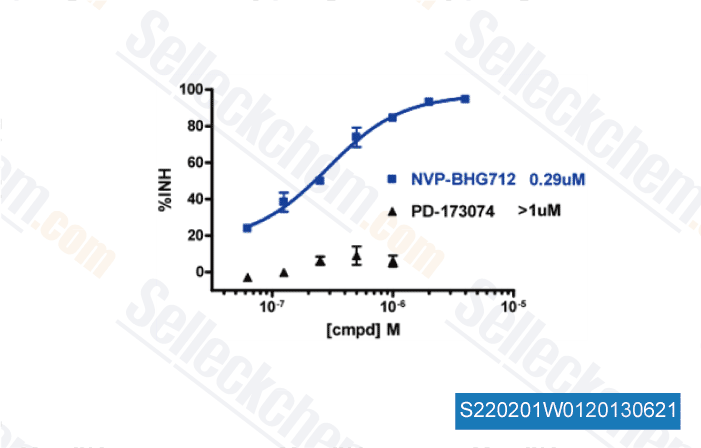|
Toll Free: (877) 796-6397 -- USA and Canada only -- |
Fax: +1-832-582-8590 Orders: +1-832-582-8158 |
Tech Support: +1-832-582-8158 Ext:3 Please provide your Order Number in the email. |
Technical Data
| Formula | C26H20F3N7O |
||||||||||
| Molecular Weight | 503.48 | CAS No. | 940310-85-0 | ||||||||
| Solubility (25°C)* | In vitro | DMSO | 101 mg/mL (200.6 mM) | ||||||||
| Ethanol | 3 mg/mL (5.95 mM) | ||||||||||
| Water | Insoluble | ||||||||||
| In vivo (Add solvents to the product individually and in order) |
|
||||||||||
|
* <1 mg/ml means slightly soluble or insoluble. * Please note that Selleck tests the solubility of all compounds in-house, and the actual solubility may differ slightly from published values. This is normal and is due to slight batch-to-batch variations. * Room temperature shipping (Stability testing shows this product can be shipped without any cooling measures.) |
|||||||||||
Preparing Stock Solutions
Biological Activity
| Description | NVP-BHG712 is a specific EphB4 inhibitor with ED50 of 25 nM that discriminates between VEGFR and EphB4 inhibition; this compound also shows activity against c-Raf, c-Src and c-Abl with IC50 of 0.395 μM, 1.266 μM and 1.667 μM, respectively. | ||||||||
|---|---|---|---|---|---|---|---|---|---|
| Targets |
|
||||||||
| In vitro | NVP-BHG712 treatment also dose dependently leads to the inhibition of RTK autophosphorylation in stable transfected A375 melanoma cells with EC50 of 25 nM and 4.2 μM for EphB4 and VEGFR2, respectively. [1] | ||||||||
| In vivo | In a growth factor-induced angiogenesis model, NVP-BHG712 (3 mg/kg, p.o) significantly suppresses VEGF stimulated tissue formation and vascularization by inhibiting EphB4 forward signaling. Furthermore, this compound (10 mg/kg/kg, p.o.) potently reverses VEGF enhanced tissue formation and vessel growth. It (3 mg/kg, p.o.) shows a long lasting exposure with concentrations around 10 μM in plasma as well as in lung and liver tissue for up to 8 hours, and thus results in a long lasting inhibition of EphB4 kinase activity in mice. [1] | ||||||||
| Features | Discriminates between VEGFR and EphB4. |
Protocol (from reference)
| Animal Study:[1] |
|
|---|
References
|
Customer Product Validation

-
,
Selleck's NVP-BHG712 Has Been Cited by 17 Publications
| Tensile force promotes osteogenic differentiation via ephrinB2-EphB4 signaling pathway in orthodontic tooth movement [ BMC Oral Health, 2025, 25(1):118] | PubMed: 39844202 |
| PDX1+ cell budding morphogenesis in a stem cell-derived islet spheroid system [ Nat Commun, 2024, 15(1):5894] | PubMed: 39003281 |
| EFNA4-enhanced deubiquitination of SLC7A11 inhibits ferroptosis in hepatocellular carcinoma [ Apoptosis, 2024, 10.1007/s10495-024-02042-4] | PubMed: 39656358 |
| NVP-BHG712 alleviates ovariectomy-induced osteoporosis by modulating osteoclastogenesis [ Eur J Pharmacol, 2024, 983:177000] | PubMed: 39278311 |
| Modelling glioblastoma migration with patient-derived cells, human iPSC-derived cortical neural spheroid, and high-content imaging [ King's College London, 2023, ] | PubMed: None |
| EGFR-phosphorylated GDH1 harmonizes with RSK2 to drive CREB activation and tumor metastasis in EGFR-activated lung cancer [ Cell Rep, 2022, 41(11):111827] | PubMed: 36516759 |
| Adaptive activation of EFNB2/EPHB4 axis promotes post-metastatic growth of colorectal cancer liver metastases by LDLR-mediated cholesterol uptake [ Oncogene, 2022, 10.1038/s41388-022-02519-z] | PubMed: 36376513 |
| Antiviral drug screen identifies DNA-damage response inhibitor as potent blocker of SARS-CoV-2 replication [ Cell Rep, 2021, 35(1):108940] | PubMed: 33784499 |
| EFNA4 promotes cell proliferation and tumor metastasis in hepatocellular carcinoma through a PIK3R2/GSK3β/β-catenin positive feedback loop [ Mol Ther Nucleic Acids, 2021, 25:328-341] | PubMed: 34484860 |
| Targeting the EphB4 receptor tyrosine kinase sensitizes HER2-positive breast cancer cells to Lapatinib. [ Cancer Lett, 2020, 475:53-64] | PubMed: 32006616 |
RETURN POLICY
Selleck Chemical’s Unconditional Return Policy ensures a smooth online shopping experience for our customers. If you are in any way unsatisfied with your purchase, you may return any item(s) within 7 days of receiving it. In the event of product quality issues, either protocol related or product related problems, you may return any item(s) within 365 days from the original purchase date. Please follow the instructions below when returning products.
SHIPPING AND STORAGE
Selleck products are transported at room temperature. If you receive the product at room temperature, please rest assured, the Selleck Quality Inspection Department has conducted experiments to verify that the normal temperature placement of one month will not affect the biological activity of powder products. After collecting, please store the product according to the requirements described in the datasheet. Most Selleck products are stable under the recommended conditions.
NOT FOR HUMAN, VETERINARY DIAGNOSTIC OR THERAPEUTIC USE.
